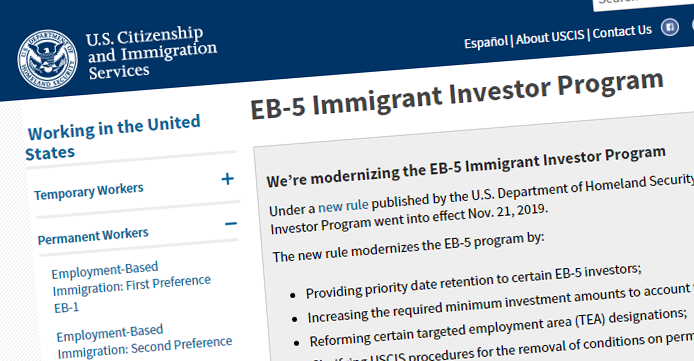
The continued decline in the EB-5 (immigrant investor) program, which has very little to do with Covid-19 and more to do with its multiple scandals, is shown in these newly published Homeland Security numbers:
| FY 2020 | Q1 | Q2 | Q3 | Q4 | Total |
| Applications | 16 | D | D | D | 34 |
What is being measured in the table above is the number of organizations applying to become a "regional center" in the EB-5 program; these are U.S.-based, middleman entities that seek profits by pooling the alien investors' funds into U.S.-based real estate investments, usually in glitzy urban areas.
The reader may well ask what "D" means. The answer is that DHS, when it comes to immigration, apparently stutters when the number falls under 10, saying (in tiny type): "data withheld to protect applicants' privacy," a ridiculous position. I say "apparently" the dividing line is nine, on the grounds that the USCIS table involved, which has 770 cells, has no cell showing fewer than 10, and at least two at the 10 level. It used to be that the "D" was only invoked when the numbers were one or two; a few years ago DHS expanded its non-reporting to the nine level.
In the first quarter of FY 2020, 16 entities sought this status. Then, by subtraction, we learn that in the last three quarters of the year, 18 more applications arrived, for the total of 34 shown above. The three consecutive "Ds" adding to 18 is consistent with the nine-and-under theory.
The total number of regional centers also continues to drop, as fewer apply and more voluntarily go out of business or are thrown out by the department. There were 880 of them in December 2018, and only 673 in January of this year.
The same Homeland Security table indicates that the number of new investors in the program is down by 95 percent from its legislative ceiling.
The EB-5 program, until November of 2019 (in the first quarter of the fiscal year), rewarded alien investors with a family-sized batch of conditional green cards, convertible to permanent ones after two years, for a $500,000 investment in a DHS-approved, but not DHS-guaranteed, project. In that month the lower limit was moved up to $900,000.
As a result of the new regulations, aliens flocked to the program in an effort to avoid the $900,000 price tag. Subsequently, the totals for new I-526 applications from individual investors dropped like a rock:
| FY 2020 | Q1 | Q2 | Q3 | Q4 |
| Forms Received | 4,264 | 21 | 40 | 53 |
One final set of numbers: Let's compare the legislative ceiling of 10,000 visas a year in this program, for both investors and dependents, with the data for the last three quarters of FY 2020. There were 114 applications filed in the last nine months. If the first three months of FY 2021 are like those of the fourth quarter of the prior year we would have 114+53 or 167 applications; let's assume that all would be approved and the usual ratio of total visas to applications, 2.5 to 1, would continue. That would produce 418 visas against the ceiling of 10,000, a drop of more than 95 percent.
This does not reduce EB-5 immigration immediately, but would allow for a substantial decrease in the multi-thousands in the backlog for Chinese investors in EB-5. The exact number made available will depend on the intricate inner workings of the visa issuance system, including the numbers not issued to other employment-based visas, and the country of origin limits. The backlogs for investors from India and Vietnam have already disappeared.
The industry will, of course, demand easier investment rules and blanket increases in visas, such as by not counting dependents in the calculations. But the program is dead in the water and no concessions are needed.
It would be helpful if more people, more journalists, and importantly, more Biden staffers, knew that the demand for these visas has fallen by 95 percent below the legislative norm.
